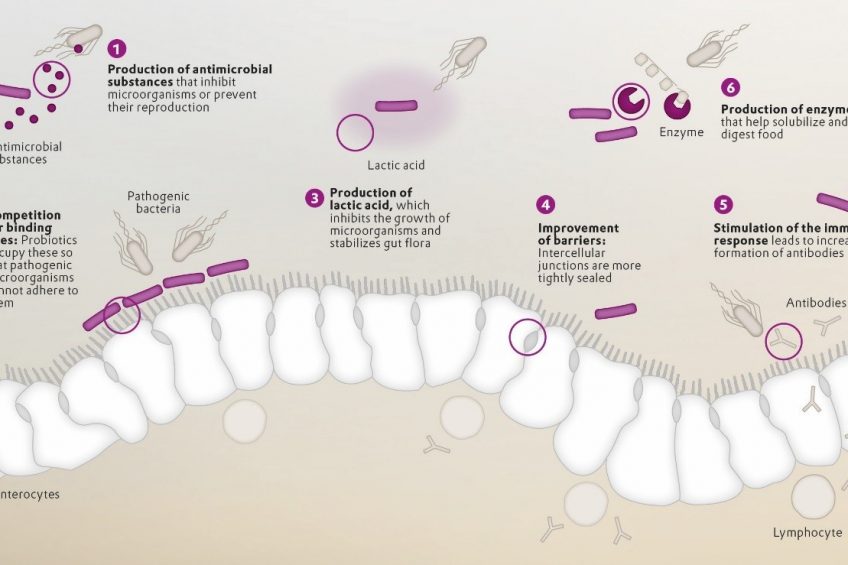Keep gut health challenges at bay

Birds are exposed to stressful conditions, such as changes in feed, poor water quality, heat stress, high stocking densities, pathogen challenges and other forms of stress causing intestinal microbial imbalances or ‘dysbacteriosis’ that have an impact on gut health. An evidence based probiotic helps to fight gut health challenges.
Global demand for meat is increasing. This is associated with a rise in the consumption of animal protein driven by population growth, urbanisation and improved standards of living. According to estimates by the United Nations Food and Agriculture Organization (FAO), global meat production will be approximately 40% higher than current levels by 2050. Poultry production in a safe, efficient and sustainable manner plays a significant role in meeting this increased demand of animal protein. In today’s intensive commercial poultry production systems, the maintenance of gut health is critical to achieve optimal bird performance, which is a key component for profitability of poultry operations. Birds are exposed to stressful conditions, often causing intestinal microbial imbalances or ‘dysbacteriosis’ that have an impact on gut health. These imbalances lead to diarrhoea, wet litter, reduced growth and productivity. This is not only unpleasant for poultry farmers to deal with, it also causes a range of ailments for the birds, thus impairing the bird’s performance and increasing overall mortality. The economic damage to the poultry industry globally, due to clostridial challenge is estimated to be between US$ 4-6 billion/year, while, it is estimated that human salmonellosis has a significant economic impact estimated to be around $ 3 billion/year.
Many functional feed additives such as probiotics, prebiotics, organic acids, enzymes, plant extracts, and mineral zeolites are already widely used and are associated with positive effects on feed efficiency, health, and animal growth. Among these, probiotics are increasingly more successful and the most potential alternatives to AGP due to 1) improved understanding and selection of beneficial probiotic organisms, and 2) their ability to remain viable and elicit specific actions within in the gut. Probiotics can positively influence gut microbiota in many different ways, for example by preventing pathogenic microorganisms from adhering to the gut wall or by modulating the immune response. Figure 1 shows schematically the most important mechanisms of action of probiotic.
Bacillus amyloliquefaciens
The probiotic composed of Bacillus amyloliquefaciens CECT 5940 (Ecobiol) was developed using several in-vitro and in-vivo tests that defined the strain’s ability to inhibit pathogenic bacteria colonising the gut. Major mechanism of action of B. amyloliquefaciens CECT 5940 include production of secondary metabolites, quorum quenching, modulation of immune system and production of lactic acid. These mechanisms promote beneficial flora, play an important role in the development and maintaining the structural integrity of the intestinal epithelium and positively modulate the immune response.
Inhibition of Clostridium perfringens
An in vitro study was conducted to test the inhibition of different pathogenic C. perfringens strains. All strains were α, β2, and netB toxin positive. The growth of all C. perfringens strains were considerably inhibited by B. amyloliquefaciens CECT 5940. In addition, several in vivo studies have been done under different challenging conditions in broiler chickens. A study conducted in Brazil (UNESP, São Paulo) using a necrotic enteritis (NE) model where birds were orally gavaged on d 17 with 1mL of Eimeria maxima (5.0 X 104 CFU/g) and Clostridium Perfringens (2.5 X 106 CFU/g) on d 18, 19, and 20. Overall, supplementation of B. amyloliquefaciens CECT 5940 to broiler diets was able to reduce feed conversion ratios and obtain significantly heavier body weights when compared to the challenged control diets. Additionally, molecular analyses of microbial populations in the ileum of treated birds showed that feeding B. amyloliquefaciens CECT 5940 consistently decreased the populations of C. perfringens (Table 1).
Another study, conducted at the Szent Istvan University, in Budapest, Hungary had an objective to determine the immunomodulatory effect of B. amyloliquefaciens CECT 5940 when supplemented to broiler chickens exposed to a NE challenge, using the Gholiamiandehkordi method. This method consists of immunosuppressing the birds using a Gumboro vaccine (CEVAC Gumbo L, Ceva-Phylaxia), followed by a cocci vaccine on d 19 ( (Paracox-5, Ceva-Phylaxia) and then challenged with a 2 mL of C. perfringens isolate (6-8×108 CFU) on d 18, 19, 20 and 21. B. amyloliquefaciens CECT 5940 was able to reduce the gut lesions produced by C. perfringens by 1 point (Figure 2).
In this same study, it was demonstrated that the supplementation of B. amyloliquefaciens CECT 5940 is able to modulate the immune response of birds depending on exposure of birds to the challenge. Broiler chickens fed with B. amyloliquefaciens CECT 5940 without a pathogenic challenge of C. perfringens had a significant up-regulation of IL-1β expression (P = 0.042) but no other cytokines were stimulated, resulting in a probable higher basic concentration of IL-1β which shows that feeding B. amyloliquefaciens CECT 5940 help to maintain a “healthy or prepared” immune system. Furthermore, feeding B. amyloliquefaciens CECT 5940 to challenged birds, resulted in an up-regulation of not only IL-1β (P = 0.044) but also of IL-2 (P=0.003) and IL-8 (P = 0.012). These observations indicate that supplementation of B. amyloliquefaciens CECT 5940 can result in differential response to express different cytokines depending on the pathogenic challenge, ensuring a smart way of allocating energy resources according to birds needs.
Figure 2 – Reduction of C. perfringens lesions score in birds fed with B. amyloliquefaciens CECT 5940 (Ecobiol).

Inhibition of Salmonella spp.
In vitro proof of concept studies were performed to determine the bactericidal effect of B. amyloliquefaciens CECT 5940 (Ecobiol) on different Salmonella spp. using the methodology described by Cintas et al., 1995. This consists of measuring the diameter of growth inhibition halo of the pathogenic bacteria through the well that contains supernatant with metabolites produced by B. amyloliquefaciens CECT 5940. Clear inhibition halos were obtained (>10 mm) with the supernatants for the following strains: S. enterica CECT 722, S. enterica CECT 443, S. enterica CECT 7161, S. typhimurium 301/99. The studies concluded that B. amyloliquefaciens CECT 5940 has a clear bactericidal effect against the listed E. coli and Salmonella strains.
Probiotics are used to balance the intestinal microbiota and therefore help to decrease carcass contamination with pathogenic bacteria such as Salmonella enterica serovar enteritidis (S. enteritidis) potentially causing a foodborne illness. Two studies were conducted with the objective to delineate the effects of feeding B. amyloliquefaciens CECT 5940 as a preventive tool against S. enteritidis infection and to evaluate the immune response under challenged conditions in broiler chickens. Analyses of cloacal samples showed that, during the entire trial period, a significant proportion of birds in the control group shed Salmonella spp. Furthermore, birds supplemented with B. amyloliquefaciens CECT 5940 had a consistent reduction (P < 0.001) of S. enteritidis. In the control group, Salmonella spp. was found in the caecal and crop samples in more than 90% of the birds, and 20% of the cases showed that this colonisation reached spleen and liver. Salmonella enteritidis colonisation was therefore significantly reduced in caecum, crop and liver in birds supplemented with B. amyloliquefaciens CECT 5940. In a second study, birds supplemented with the same B. amyloliquefaciens CECT 5940, and challenged with a S. enteritidis isolate had reduced (P = 0.02) Salmonella counts in the caeca and litter and increased (P = 0.008) goblet cell numbers in both ileum and caecum. Additionally, these supplemented birds had lower CD8+ cell counts at d 35 of age when compared to the control birds.
Figure 3 – B. amyloliquefaciens CECT 5940 (Ecobiol) improves body weight, decreases feed conversion ratio and mortality under various feeding conditions.

Modulating microbial population
A large scale commercial study was conducted using 60,000 broiler chickens. Birds were placed in 6 houses each containing 10,000 broiler chickens. 3 broiler houses received B. amyloliquefaciens CECT 5940 (Ecobiol) while other 3 houses were control. In these farms, samples of faeces were collected to analyse lactobacilli, coliform and clostridium bacteria (CFU/g) at 7 and 35 days. Feeding Ecobiol increased the Lactobacillus counts in faeces both at d 7 and at 35 while reducing coliform counts. Furthermore, nine studies were conducted to test the efficacy of the probiotic strain B. amyloliquefaciens CECT 5940 under various feeding conditions across the world (Figure 3). Overall, feeding B. amyloliquefaciens CECT 5940 improved body weight gain by 1.84%, decreased FCR by 2.78% and decreased mortality by 1.15%. Based on these results, it is concluded that dietary supplementation of B. amyloliquefaciens CECT 5940 can consistently improve broiler performance when potential gut health challenges exist, under various feeding conditions.
 Beheer
Beheer




 WP Admin
WP Admin  Bewerk bericht
Bewerk bericht